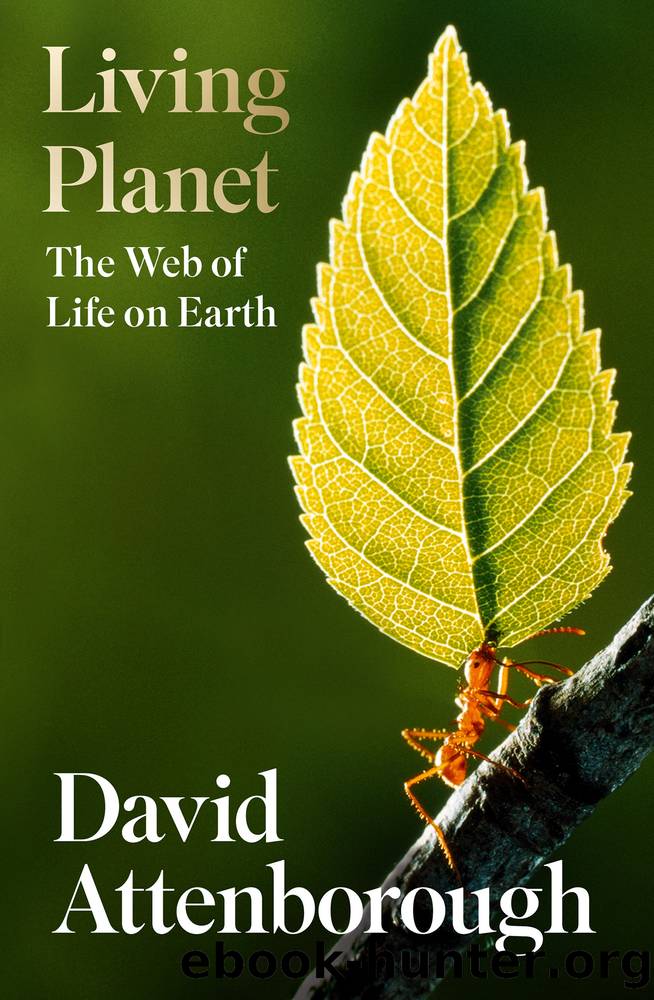Living Planet by David Attenborough

Author:David Attenborough
Language: eng
Format: epub
Publisher: HarperCollins Publishers
EIGHT
Sweet Fresh Water
The snow flakes, falling so gently on the mountains of the world, are agents of destruction. They mantle the peaks in fields metres deep. Their lower layers, compressed by the weight above, turn to ice. It closes around projections of rock and penetrates the cracks and joints. As the snow continues to fall above, the ice beneath begins to move slowly down the steep slopes under its own weight, dragging away plates and blocks of rock as it goes. Most of the time, the movement is so slow that its only visible signs are widening cracks across the snowfield. On occasion, the whole sheet suddenly loses its grip and thousands of tons of ice, snow and rock sweep down the mountain.
All this frozen water, gathering in the vast couloirs between the mountain ridges, unites to form a river of ice, a glacier. Now the destruction becomes devastating. As the glacier slides downwards, it scrapes away at the sides of the valley against which it presses. Beneath, boulders frozen into its underside, like teeth in a gigantic rasp, grind down its bed. Ahead, it pushes a huge wall of shattered rock. Slowly it inches downwards below the level of permanent snow until the warmth begins to melt it, and water, creamy with pulverised stone, gushes from its snout.
Rain, falling on the mountain at these lower altitudes, is also a destroyer. During the day, it trickles harmlessly over the bare rock faces and permeates their crevices, but at night, when it freezes, it expands and wrenches away splinters and flakes which tumble down to join the piles of angular fragments skirting the bottom of the cliffs. The rivulets unite into streams and join the waters flowing from the glacier. Together, they tumble and eddy down the valley as a young and violent river.
This water, in global terms, is a rare liquid. Ninety-seven per cent of all the water on earth is salty. This, although it carries many rock particles in suspension, is chemically very pure. As it fell from the clouds through the atmosphere, it absorbed some carbon dioxide and oxygen, but very little else and so far it has had little chance to dissolve minerals from the newly exposed and largely unweathered rocks it has crossed. But gradually, as it rushes on, it collects organic particles from the mountain plants growing between the boulders near its margins, and eventually it acquires just enough dissolved nutrients to support animal life.
Any creature that tries to make a permanent home in these rushing waters has to develop a method of preventing itself from being swept away. The larvae of the big hump-backed bloodsucker, the blackfly, attach themselves to the stones with a tiny circlet of hooks at their hinder ends and allow their legless, worm-like bodies to trail in the current. Occasionally, one moves farther into the river, curving down to grip a pebble with a small sucker at its front end, and then looping its body to get a new grip with its main hooks.
Download
This site does not store any files on its server. We only index and link to content provided by other sites. Please contact the content providers to delete copyright contents if any and email us, we'll remove relevant links or contents immediately.
The Lonely City by Olivia Laing(4190)
Animal Frequency by Melissa Alvarez(3822)
All Creatures Great and Small by James Herriot(3601)
Walking by Henry David Thoreau(3300)
Exit West by Mohsin Hamid(3279)
Origin Story: A Big History of Everything by David Christian(3202)
COSMOS by Carl Sagan(3009)
How to Read Water: Clues and Patterns from Puddles to the Sea (Natural Navigation) by Tristan Gooley(2942)
Hedgerow by John Wright(2832)
The Inner Life of Animals by Peter Wohlleben(2819)
Origin Story by David Christian(2747)
How to Read Nature by Tristan Gooley(2736)
Project Animal Farm: An Accidental Journey into the Secret World of Farming and the Truth About Our Food by Sonia Faruqi(2724)
How to Do Nothing by Jenny Odell(2710)
Water by Ian Miller(2655)
A Forest Journey by John Perlin(2643)
The Plant Messiah by Carlos Magdalena(2504)
A Wilder Time by William E. Glassley(2413)
Forests: A Very Short Introduction by Jaboury Ghazoul(2397)
